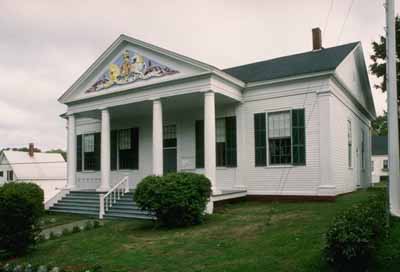Charlotte County Court House National Historic Site of Canada
Saint Andrews, New Brunswick

General view
© Parcs Canada | Parks Canada, 2003.
Address :
123A Frederick Street, Saint Andrews, New Brunswick
Recognition Statute:
Historic Sites and Monuments Act (R.S.C., 1985, c. H-4)
Designation Date:
1981-06-15
Dates:
-
1832 to 1836
(Construction)
-
1858 to 1858
(Significant)
-
1839 to 1840
(Addition)
Event, Person, Organization:
-
Thomas Berry
(Architect)
-
Charles Kennedy
(Builder)
Other Name(s):
-
Charlotte County Court House
(Designation Name)
Plaque(s)
Approved Inscription: 123A Frederick Street, Saint Andrews, New Brunswick
The proximity of these two buildings speaks to their interrelated functions, a notable theme in the early history of Canada’s judicial system. This modestly scaled stone prison, completed in 1836, illustrates detention conditions in small towns in the early 19th century. The construction of this freestanding prison meant that the courthouse did not need to detain prisoners and could be given a more refined appearance to portray the dignity and decorum of the justice system. The impressive wood courthouse, completed in 1840, is the best-preserved example of its type in New Brunswick.
Description of Historic Place
Charlotte County Court House National Historic Site of Canada consists of a court house and a gaol. Set on an elevated site, they share the same lot in the town of Saint Andrews, New Brunswick. Built in 1839-1840, Charlotte County Court House is a simple, one-and-a-half-storey, wood-frame building with a monumental pedimented portico. The Charlotte County Gaol, which dates to 1832, is a modest two-storey stone building. The formal recognition consists of the courthouse and the gaol on their legal property.
Heritage Value
Charlotte County Court House was designated a National Historic Site of Canada in 1981. It is recognized because:
built in 1839-40, the Charlotte County Court House is the best preserved example in New Brunswick of the typical mid-19th century Maritime court house; built in 1832, the Charlotte County Gaol is a modest-scale prison which served as the county prison continuously for nearly 150 years, and represents the detention conditions in small municipalities beginning in the first half of the 19th century in British North America; the strong relationship and proximity of the gaol and court house speak to the historical dual function of courthouse and prison, a notable theme in the early history of Canada’s judicial system.
The Charlotte County Court House is typical of mid-19th-century county court houses in the Maritime Provinces in its composition, form, materials and classical features. Its simple, wooden, vernacular form is distinguished by monumental features appropriate to its function and status in the community. These include an elevated site, a prominent pedimented portico, and classical masonry detailing translated into wood. Charlotte County Court House was situated adjacent to the county gaol for functional reasons. The elegance and fine craftsmanship of the courthouse reflect the community’s prosperity and pride in its public buildings, particularly those associated with the justice system. A royal coat of arms representing the British origins of the Loyalists who settled in the area was carved into the tympanum of the pediment by Charles Kennedy in 1858.
The gaol, a two-storey building constructed of granite stone blocks devoid of exterior ornamentation, is an example of utilitarian classicism. The court house is the more prominent building with the gaol situated to the rear at a lower elevation. Both feature prominently in the historic district of Saint Andrews.
Sources: Historic Sites and Monuments Board of Canada, Minutes, June 1981; November 1982; December 2015.
Character-Defining Elements
Key elements contributing to the heritage value of this site include:
Charlotte County Court House its vernacular form, low-massing and composition, consisting of a symmetrical, one-and-a-half-storey clapboard building, five bays wide, a medium-pitched gable roof, and a classical portico intersecting the gable roof; its classical features and detailing, including an elaborate pedimented portico with decorative mouldings, Tuscan columns and broad entrance steps, and pilasters at the corners of the building and on either side of the entrance; its openings, including double entrance doors topped by a large, multi-pane rectangular transom, and large multi-pane windows symmetrically placed on either side of the entrance doors; the carved and painted coat of arms on the tympanum of the pediment; its construction of local pine with a random ashlar foundation; the high quality of its construction and craftsmanship; its elevated siting; its relationship to other county buildings, including the adjacent gaol, and the nearby registry office.
Charlotte County Gaol its modest scale, consisting of two-storey granite-block building with no ornamentation; its hip roof; its simple and functional plan; the integrity of ground floor plan, consisting primarily of the old cells; its proximity with the court house, set back to the rear and at a slightly lower elevation.
Site The strong relationship and proximity of the court house and gaol; The location of the buildings on an elevated site within a residential neighborhood near downtown.